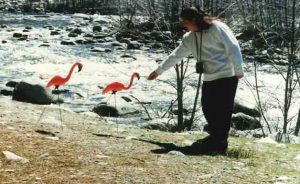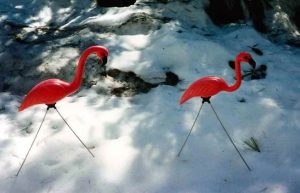

For the mere price of one dollar, how could anyone pass up a used book with such an enticing title? For a money-challenged graduate student, How to Make Cheap Wine was a roadmap to a continuous flow of low-cost nectar of the gods. How hard could it be? After all, Neolithic man made wine, without the aid of a recipe from a second-hand book. With a little study and preparation, I might be able to produce the same results as illiterate, ancient cave-dwellers.
I Am My Hat
A Short Story by Howard Feigenbaum
I Am My Hat
 The meaning of appearance came to me one day in childhood. My mother allowed me to pick my clothes. A new world dawned. I could look like the people I admired. And the colors—hoo-hah! The combinations of red, blue and green were endless, and I was the canvas. The gates guarding the entrance of the path to free will had swung open.
The meaning of appearance came to me one day in childhood. My mother allowed me to pick my clothes. A new world dawned. I could look like the people I admired. And the colors—hoo-hah! The combinations of red, blue and green were endless, and I was the canvas. The gates guarding the entrance of the path to free will had swung open.
Of the choices available, I found the hat, above all else, the most expressive piece of clothing. In a matter of seconds, my image was transformed. The symbolic shift rested on my head for the world to see. My mind adjusted.
My first encounter with a hat was in my infancy. An aging photograph showed me wearing a wool hat my grandmother knitted in advance of my arrival into the world. This hardworking woman, who had an indentation in her right index finger from years of knitting needles resting on that spot, did what she knew best to show her love. There it was, her love, enveloping my head, protecting me from the cold Catskill winter.
The next significant hat in my life was the cowboy hat—the heroic good guy hat, not the bad guy hat. Cowboys helped people. They were brave. They cared about their horses. I wanted to be one of them. With the hat on my head, I was.
When I think about my cowboy period, I realize that an understanding of the basics of morality drew me to the mythic figure. Even now, I wouldn’t mind being a cowboy. Of course, I would need a hand getting into the saddle.
My love for cowboys led me to the first crisis in my young life. Mom arranged for my sister and me to take tap dancing lessons at seven p.m. on Tuesdays—the same time that Gene Autry and his horse, Champion, appeared on channel five. What a calamity. After a few months of lessons, I learned that we were to appear in a school dance recital and perform to the tune On the Good Ship, Lollipop—with a massive piece of cardboard behind us, painted to look like a steamship. Not only would my friends see me tap dancing, but I would be dressed in white pants and a blue blazer with gold buttons. A hat turned everything around. My role, the captain of the good ship, required that I wear the captain’s hat to complete the costume. Hallelujah! Everyone would know that I was the captain. Power and the prestige came along with the hat’s gold braid. I happily shuffled into a time step and twirled my sister.
The usual hats of youth fascinated me, especially the odd-looking Daniel Boone coonskin cap with its defining tail. If the tail came off, the hat was no longer authentic. If you ever wore an untailed Daniel Boone cap, you risked being asked a thousand times, “Where’s the tail?” A surplus World War II Army helmet, along with a toy wood rifle, brought me into the righteous battle of defending America. The World War I pilot’s hat, with goggles, did look a bit goofy without a bi-plane nearby. The baseball cap was mandatory. My cap, with the New York Yankee insignia on the front, was a consistent winner.
An unexpected turn of events brought a new understanding of hat power. I visited my grandparents who vacationed in Miami Beach during the winter. At the beach, I amassed a wonderful collection of sea shells. My grandmother bought me a florescent orange fishing hat to protect my face and neck from the Florida sun, and probably to easily spot me as I wandered along the shore. As a surprise, before I returned home, she sewed a substantial number of the sea shells onto the hat. What an impressive sight. I was sure no other hat like it existed. You couldn’t have bought the hat from me for a million bucks, although no one tried. But if they did, I had an answer ready.
When I returned to school, I decided to wear the “shell hat,” as I fondly called it. My cousin, Ellen, whom I loved and admired, was eight years older and in high school. In our town, all the grades occupied one building. One afternoon as the school day ended, the unpredictable happened. I caught sight of Ellen walking down the hall with two girlfriends. I waved and called out, “Hi, Ellen. Hi.”
After a quick glance in my direction, she averted her gaze and walked on.
Later that day, my mother received a phone call from Ellen. “Aunt, Adele, can you please ask Howard to stop wearing that hat to school?”
What a coup! Ellen noticed me, not in a good way, but she noticed me. The hat functioned like a magnet. Her request to my mother was proof. After the “incident” at school, my desire to wear the hat increased. Who knew how many people wanted to spend a few moments taking in the sight of that marvelous chapeaux and the person wearing it? Maybe hundreds, I thought. The hat would make me famous.
In junior high, I favored the black motorcycle cap with the flying wheel emblem. The hat complemented my leather jacket and sent a subtle message, “Don’t mess with me. I’m the kind of guy who could kick your ass.” Marlon Brando’s The Wild One role was the blueprint. Of course, I wasn’t that kind of guy, but neither was Marlon. However, advertising the ass-kicking possibility might discourage some hormone-fueled, pre-teen young man who had a combative nature. I backed up the image with a practiced serious stare, sunglasses and a “Detroit” ducktail haircut. The best part, when my reflection appeared in windows, was asking, “Is that really me?” and answering, “Boy, do you look tough.”
John F. Kennedy disfavored wearing a hat. So, in high school, I followed suit. Those were the “hatless years.”
After purchasing a Suzuki 150 motorcycle for commuting to UCLA, I returned to the hat. At a neighborhood Scottish imports store, I adopted the English beret and the MacLeod clan yellow plaid wool scarf. Lacking an impressive motorbike, I thought the continental look would more than make up for a having a whining engine instead of the full-throated roar of horsepower. I imagined the ladies asking, “Who is that dashing young man on the small motorcycle?”
In adulthood, I became an aficionado. As I built my collection, inspiration came from everywhere: the Hamburg and fedora from my grandfather, the newsboy cap from Robert Redford in The Sting, the backward Kangol cap from my soul brother, Samuel L. Jackson, and the Panama hat from Teddy Roosevelt.
The high point of my headgear round up was my pilgrimage to Montecristi in the mountains of Ecuador, a literal high point. The journey brought me to the true home of the Panama hat. I watched a craftsman shred agave for the fibers, which diminutive women wove on bulky wood looms to create the unique fabric.
When made well, the topper holds water without leaking. In times past, an Ecuadorian riding through the mountains could pour water from a canteen into the sombrero and allow the horse to wet his whinny. This feature sold me on owning the magnificent Montecristi millinery. After all, with my cowboy background, how could I say “no?”
Ansel vs Howard: The Battle of Yosemite
A Short Story by Howard Feigenbaum
 Ansel vs Howard: The Battle of Yosemite
Ansel vs Howard: The Battle of Yosemite
Twenty-two years ago, an April family vacation to Yosemite, the land carved by glaciers, set me to thinking. As I packed, my mind settled on a discomforting thought. How could my puny, predictable thirty-five millimeter photographs ever compare to Ansel Adams’ majestic prints? I wanted to avoid joining the multitude, cameras slung around their necks, who would have done better buying postcards featuring the master’s work.
Who would an amateur nature photographer admire more than Ansel Adams? Nobody. His photographs are synonymous with Yosemite National Park. Ansel’s large format view camera, his patience in waiting for the perfect moment to shoot the scene and his skill in the darkroom combined to portray the beauty and drama of Yosemite.
Sure, he had a proven system for composing and processing his iconic images.
But I had something Ansel never could have imagined—two plastic, pink flamingos, purchased at the Armstrong Garden Center and placed with care on top of the luggage in the car trunk. If his work was iconic, I would go the other way—iconoclastic. My photographs would juxtapose the park’s natural splendor with crass, mass-produced symbols of the tasteless. I would become the “anti-Ansel” of Yosemite—my David to his Goliath. Watch out, Ansel. The battle had been joined.
The day of reckoning arrived. We parked near a breathtaking meadow with sparkling waterfalls in the distance. I opened the trunk, lifted out the birds and marched to a location that would provide the perfect scene—plastic, pink flamingos in the foreground accompanied by lush green fields and splashing cascades in the background.
Fellow tourists watched with interest, pointing and murmuring.
“Dad, do you have to?” asked my young daughter as I shoved the iron rod bird legs into the ground. The whine in her voice made clear she didn’t want us singled out for attention.
“I have to do this, Andrea. It’s a new concept. Bear with me.”
When we moved on to Half Dome, she said, “Dad, not again.” After Yosemite Falls and El Capitan, she surrendered to the inevitable.
The next day, while setting up flamingo shots, I noticed something which escaped me the day before—something miraculous. After I positioned the flamingos and opened the legs of the flimsy aluminum tripod holding my Canon AE-1, I observed people laughing and grinning. Eureka! I understood. They entered my world. The image existed in their mind’s eye, even before I snapped the shutter. The unprocessed Kodachrome film had not yet produced a single print—yet they enjoyed the composition as if it were printed on paper and set before them.
My bold attempt to outmaneuver Ansel produced an unexpected breakthrough. I had bridged the chasm between two worlds, photography and art. I had stumbled into becoming the first impressionist photographer. The suggestion of my vision created the finished impression in the viewer’s mind. Claude Monet and I were now soul brothers.
I declared a truce in my contest with Ansel. He still reigned as the master photographer of Yosemite. But I gained a new status in the struggle—the pioneering iconoclast, impressionist photographer of Yosemite.
On our last day, we ventured up to Tioga Pass, nine-thousand feet above sea level.
After parking the car, I set up the two flamingos in a snow bank. As I prepared to shoot, a bus filled with Japanese tourists came to a halt. Almost in unison, they lowered their windows, pointed their cameras and clicked away. A once-in-a-lifetime scene appeared before them—pink flamingos in the snow. The folks at home would never believe this.
When I reflect upon that magical time, I like to think the images of plastic, pink flamingos in Yosemite exist in the minds of those still living who bore witness.
As for the Japanese tourists who stopped on Tioga Pass that day, long-forgotten fading Fujifilm prints, languishing in boxes on closet shelves, testify to the reality of their experience—but not to the truth. Imagination interfered with realism.
“Lying,” as Oscar Wilde wrote in his essay, Decay of Lying, “the telling of beautiful untrue things is the proper aim of Art.”
Ansel, my nature-loving hero, each of us told untruths—you, in the darkroom, I, in contrasting the absurdly artificial with the pristine. No doubt your photographs are awe-inspiring. But who’s getting the laughs?
Writer as Artist
The Writer as Artist
Creativity and format shape the writer’s work. The story depends on the ideas the writer brings to the page. The rules of English composition, grammar and punctuation affect readability. How frustrating. If only I could transmit ideas to the reader without paying attention to the rules.
A comparison of writing to painting is worthwhile. I have had the good fortune to learn the visual arts, photography and painting. My fifth grade art teacher, after a year of seeing my drawing and painting, said that I shouldn’t continue with art. I believed her until later in life when photography, then painting, held my interest. Her words still lived in my mind until I discovered that talent wasn’t required for art. One had to learn the rules and apply the lessons. Practice, in my case, did not lead to perfection—but it brought me a heck of a lot closer.
I realized that the images I sought to portray depended on attracting and holding the viewer’s attention through the use of colors, values, contrast and composition. Easy to say, but hard to do. You must give yourself over to the medium. Why do artists do that? Above all, they want to communicate an idea. For the devoted among us, the journey may lead down the path to mastery.
Everyone has access to paper and pencil, but not everyone will be an artist. Some will be dilettantes, having a superficial interest that culminates in a hobby.
What makes the writer an artist? I believe it’s the individual’s dedication to the process of fusing creativity with structure and understanding what appeals to the audience—peppered with inspiration.
We sort ourselves out. Nobody says who can be or can’t be an artist or a writer. No license required. But, in the end, we know.
A Tale’s Sense of Place.
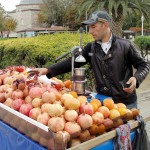 The Art of Being There in Fiction.
The Art of Being There in Fiction.
I have found that the best way to bring a sense of place to readers is through research. The characters may be fictitious, but the reality of location makes the story more interesting and believable.
Many people enjoy reading novels that are set in places they visit. I am one of them. In my youth, I read about the ancient Minoan civilization on the island of Crete. The story stoked my desire to see the place for myself. When I visited the ancient ruins, it was like enjoying an impressionist painting. The structural foundation was there, and my knowledge completed the picture.
Much of the action in the first volume of my Benny Goldfarb, Private “I” series takes place in Colombia. I researched the locations, the history, the culture, and the food. The next year, after the book’s publication, my wife and I had the good fortune to visit Cartagena. We hired a driver to take us on a tour of the city, stopping at places described in the book. He heard me informing my wife, in detail, about the sites. “You have been here before?” he asked. I explained that I was an author. My mind had been here before. This was the first time for my body.
A story can be more than a story. It can morph into a three-dimensional experience that comes alive when you visit the setting—but only if the writer’s research is woven into the tale’s fabric.
The Path to Writing
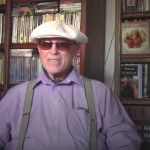 The Path to Writing
The Path to Writing
Check out my new YouTube video, Interview with Howard Feigenbaum, produced by fellow author Jim Hitt. In this video I discuss my decision to become a writer and offer advice for those who wish to become writers.
Authenticity of Fiction
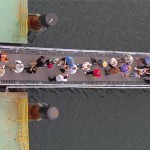 A Cultural Bridge
A Cultural Bridge
Traveling to a country and being there is an important advantage for a writer. Research can’t replace the impressions and feelings one experiences by immersion in the culture. The sound, the look, the language, the humor, the food—all of these make an impact that color the story.
What difference does personal experience make? After all, a work of fiction is what you want it to be. The authenticity of details enhances what is believable. Even readers of fiction will reject descriptions that are inaccurate or don’t ring true. Their attention leaves the story and grapples with what is out of place. The logic of the human mind is always at work.
In some ways, writing is like painting. Most people appreciate realism, firmly planted in the truth of accurate portrayals. Many people will accept impressionism, relying on gestures and forms which rely upon the viewer’s mind for completion. Furthest away from popular taste is abstraction, a created world with few familiar signposts, requiring the viewer to search for meaning in unfamiliar territory.
Art has no definition. Popular acceptance does.
One thing travel has taught me.
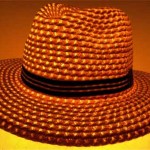 A New Hat – How Illuminating?
A New Hat – How Illuminating?
Hat Illuminated.
A word of warning to people who wear hats on the top level of the hop-on hop-off buses: your hat and your expectations are at risk. I learned the hard way in Buenos Aires. The bus turned a corner. A gust of wind blew. My favorite brown newsboy cap took off across one of the wide streets of the city. There was nothing to do but wave good-bye to an old friend.
As fortune would have it, when the bus returned to the station, there was a street vendor selling hats. He had them arranged on spokes sticking out of a pole. My wife picked out a nice-looking straw hat that fit nicely. The loss of a hat created an opportunity for a acquiring another that would be a fine example of Argentine handiwork. What a stroke of good luck. After examining the hat, I noticed a small tag attached to the sweatband: made in China.
Sure I was disappointed. But not as disappointed as when I bought a bolo tie in Arizona—in the heartland of native-American culture—and the country of origin stamped on the back of the slide broke my heart. If travel has taught me one thing, it’s that my memories of the people and places are the only authenticity I can count on.
Good Enough to Eat
 I like to have my characters enjoy a good meal.
I like to have my characters enjoy a good meal.
Barbeque Peru Hacienda
Food is fascinating. If you’re writing about location, why not include food? The characters in the Benny Goldfarb, Private “I” series spend a lot of time in South America. The cuisine changes from country to country, depending on the agricultural traditions. For example, Argentina is big on beef and empanadas. Peru offers a smorgasbord of almost endless types of potatoes. The menus in Colombia are loaded with fish. In my experience, readers enjoy having the local food incorporated into the story.
From my point of view, food is part of a culture. I like to illuminate the setting that characters occupy by occasionally referencing the meals. The reader makes a silent judgment about the food. Sometimes curiosity about a particular dish is aroused and satisfied. The ingredients may add to a feeling of what life is like in that distant place. In any case, I like to have my characters enjoy a good meal. Why not? It’s my story. And they seem to like the experience.
The Music of Life
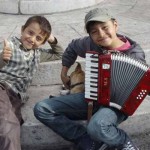 The Music of Life
The Music of Life
playing music in town square, Rhodes
Everywhere is different. Everywhere is the same.
We see the world as we travel through it, noticing the things that vary from what we know: the language, the customs, the clothing, the food, the architecture. But the people are not so different. The only thing missing in our encounter is that we don’t know each other.
In the town square, two boys sing and play the accordion. We enjoy. The simplicity and innocence of youth draws us to them. We instinctively care. Our smiles begin the introduction to hearing the music of life.
Attaboy, Attaturk.
 Attaboy, Attaturk.
Attaboy, Attaturk.
Attaturk statue in harbor, southern Turkey.
Mustafa Kemal Attaturk, the father of modern Turkey, made revolutionary changes in Turkish society. The first president of Turkey abolished the existing caliphate, separated the state from Sharia law, abolished the use of Arabic while establishing a Turkish language and modernized the country. Women were free to choose their mode of dress. He encouraged the adoption of western styles.
For me. Attaturk’s preoccupation with the hat is fascinating. He wore a Panama hat, among others. Fedoras, derbies and other western hats were, to him, symbolic of a civilized nation. He required civil servants to wear hats and suits. As a writer, and as a lover of hats, headgear is a visual representation of one’s presentation to the world. We know this from watching old-time western movies. The good guys wear white hats, the bad guys wear black. When we see the hat, we know they are cowboys.
When I visited a small town along the southern Turkish coast, I saw a statue commemorating Attaturk. He was wearing a newsboy-style cap. I was wearing a newsboy-style cap. Immediately, I felt an affinity for Attaturk. We were hat guys. We even preferred the same style. The description of a character’s clothing is important for the reader. The detail in appearance tells a story of its own.
Work – a tale of perfomance.
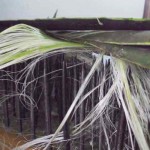 Work – and how performance tells a tale.
Work – and how performance tells a tale.
photo of shredding agave – Manta, Ecuador
The job doesn’t matter. It’s how the character performs the work that tells a tale.
I love professional waiters. They make the dining experience worthwhile. Knowledge of food and drink is important. Knowledge of people is even more important. For me, excellence deserves respect. Mediocrity does not. We all have our opinions about how people behave. I think most of us would usually agree on issues of good and bad. When words describe the behavior, we can share the vision.
I had the pleasure of visiting Montecristi, Ecuador, the home of the Panama hat. The manufacturing process is low tech. Leaves of the agave plant are shredded to get the fibers for weaving the hats. The quality of the fibers determines the quality of the hat. The people who made the hat I bought were proud of their product. I think of the hat’s beauty every time I wear it. And, in the third volume in the Benny Golfarb series, when I relate the adventure in Ecuador, the hat and the native people in the mountains above Manta, will shape the writing.
Food – “Tell me what you eat…”
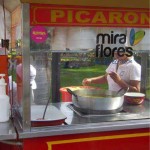 Food - what the locals are eating.
Food - what the locals are eating.
photo of picarones cart in Mira Flores, Lima, Peru
“Tell me what you eat, and I’ll tell you what you are.” Frenchman Brillat-Savarin believed that food had its own story to tell. I agree. Writing, travel and food come together in providing a snapshot of a culture. Eating what the locals eat is the first step in appreciating who they are.
Benny Goldfarb, Private “I” has descriptions of what characters are eating in Colombia. My colleagues often tease me about a chapter making them hungry. That is an unfortunate side effect. I believe that by sharing the same cuisine, I move toward greater cultural appreciation. Speaking the same language also has a similar result. There are concepts couched in speech that have cultural nuances.
What might a citizen of Lima feel on a weekend afternoon in Kennedy Park when enjoying freshly-made picarones, a doughnut-like treat? There’s one way to find out—get in the line at the kiosk, and wait your turn. You will know what generations of Peruvian parents and children have relished.
Inside a Book’s Main Character: A Jewish Detective.
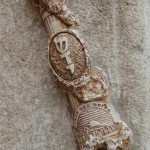 Looking Inside a Book’s Main Character.
Looking Inside a Book’s Main Character.
Is Benny Goldfarb, the protagonist in Benny Goldfarb, Private “I”, a Jewish character or a character who happens to be Jewish? He is a man with a moral sensibility and an appreciation of how that happened.
In writing, characters demonstrate who they are through behavior and their reaction to events. In general, we don’t know the religion of the protagonists in the books we read. However, when someone has a name like Benny Goldfarb, an assumption occurs. If the reader makes that assumption, why not satisfy the curiosity—not as the focus of the work but as an interesting detail.
Why should the majority of detective/action/adventure characters have Anglo-Saxon or French names? In this case, Benny Goldfarb is an American who works as a private investigator. In truth, he cannot escape the perception of his ethnicity. In the story, his thoughts and feelings are shaped by his tradition and religious beliefs.
A visit to the Palace of the Inquisition in Cartagena, Colombia transforms Rosa Zuleca, the main female character, when she confronts the effects of the Spanish Inquisition on her family. Although this theme is a subplot, it adds depth to the story by introducing a setting where history, injustice and an individual’s identity meet.
When a horse is not a horse.
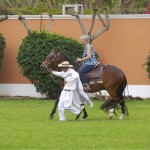 History and Tradition – photo of Paso Fino
History and Tradition – photo of Paso Fino
When is a horse not a horse? When it’s a Paso Fino. Peruvian respect is profound for a breed of horse unique to the nation. The small, sturdy, smooth-gaited horse improved travel over long distances in mountainous terrain. Hacienda owners loved the Paso Fino. Why is this notable to me as a writer? The animal is a physical representation of social class. If I write about Peruvians, I should consider where someone fits in the power and economic structures of the country. The issue is part of the realistic detail that benefits the believability of fiction.
James Michener, in Hawaii, does that very thing. The development of his characters occurs within the context of where they fit in a tribal society meeting the modern era. The writer can show who characters are, not only by what they say and feel, but also by their social position.
Experience – the effect of Cape Horn.
 Experience - photo of Cape Horn
Experience - photo of Cape Horn
What’s it like to round the Horn? For me, the experience was extreme. In the space of two hours, there was rain, hail, high winds, snow and sunshine. How did this affect me as a writer? I understand why the Bounty’s crew mutinied. In the movie, Captain Bligh informs the crew that he is taking them back to England by way of Cape Horn. The crew protests, “No, not the Horn!” Shortly after, they seize the ship and turn back to Tahiti. After experiencing the Horn, I would have joined them. Who wouldn’t? Half the ships rounding the horn foundered on the rocks. Their descendants inhabit southern Chile.
Nordhoff and Hall, the authors of Mutiny on the Bounty, traveled to Tahiti. The story benefited from their experience. Their research included perusing Captain Bligh’s journals, the ship’s log and historical accounts. The rich detail in a work of fiction is a thing of beauty.
The Geography of writing.
 Geography – photo of Ecuador
Geography – photo of Ecuador
Everyone has to be somewhere. Is that too obvious? Not to me as a writer. I feel an obligation to help the reader imagine the setting. The geography affects the ease or difficulty of movement. The flora, fauna and weather contribute to a sense of environment.
The Andes shape the use of South American countries. They are a barrier running down the interior of the nation. If you are wealthy, the range is something to be flown over. If you are not-so-rich, the bus trip can take days, or longer if landslides block the road. The isolation of the Incas and other native groups helped them evade the Spanish conquest. Native cultures still flourish at high altitudes. In Benny Goldfarb, Private “I”, the protagonists travel into the interior of Colombia. The detail of the story almost demanded the inclusion of a native group. In this case, the Paez tribe provides another point of view in Colombian society.
My take on Argentina’s normal.
 Culture - photo of Buenos Aires
Culture - photo of Buenos Aires
I have been to Argentina twice. I love the country’s physical beauty, the friendliness of the people and the food. Travel gives me an advantage. I have experienced the reality of how things are. I can incorporate the detail in my story.
Currently, I am finishing the second book in the Benny Goldfarb, Private “I” series. The setting is Argentina, Brazil and Paraguay. While I constantly research as I write, the experience of being there adds depth to the quality of the writing.
Argentina, like other countries in South America, has a colonial history. The architecture reveals something about the culture. The country still has close economic and social ties to Spain. However, Buenos Aires, like Brasilia, has a fascination with modern architecture. The Puerto Madero neighborhood, built on land reclaimed from the Rio de la Plata, breaks with the past in its physical footprint. Who are the Porteños, as citizens of Buenos Aires call themselves? They are romantic. They invented the tango. They take time out to have drinks with family and friends. They eat the best beef in the world. They love horses and futbol. They have a mythic figure, the gaucho. They have a history of turbulent national politics and corruption.
As I write my story, I try to paint the characters with my understanding of what is normal in their world. I believe the reader appreciates the nuances in the portrayal. Even if the reader hasn’t been to Argentina, he or she can catch a glimpse. I love it.

